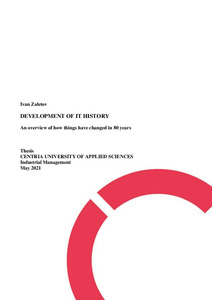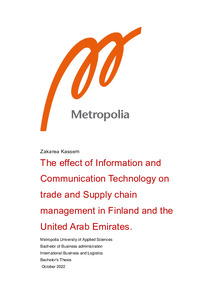Excitement or anxiety: Investigation of companies’ usage and attitudes towards GAI as a supportive technology for Human-AI collaboration in businesses. Insights from ICT specialists
Matanovic, Lidija (2025)
Matanovic, Lidija
2025
All rights reserved. This publication is copyrighted. You may download, display and print it for Your own personal use. Commercial use is prohibited.
Julkaisun pysyvä osoite on
https://urn.fi/URN:NBN:fi:amk-202503134199
https://urn.fi/URN:NBN:fi:amk-202503134199
Tiivistelmä
As GAI is starting to become more integrated into business, it has become crucial to clarify whether humans and GAI are currently collaborating in corporate settings, and the impact of this new technology on European enterprises. This research investigates the role of GAI and its adoption in the ICT sector, by exploring its usage. It examines how frequently GAI tools are used in a company at three corporate levels in seven European countries and identifies the GAI tools ICT specialists use for their daily tasks. It explores how GAI is influencing and changing these professionals’ work habits, improving their knowledge work, and transforming their jobs. It assesses the steps needed to navigate the risks and possibilities related to GAI.
The participants were ICT specialists working in various industries from Bulgaria, Finland, France, Hungary, Germany, Romania, and Sweden. Data were collected through an online questionnaire using Webropol, which was shared on LinkedIn to reach large groups and communities of ICT experts.
The quantitative results acknowledged how, by taking seven EU nations under study, in the ICT industry the integration of GAI tools is growing and how these are becoming crucial to routine operations. The findings could generalize that ICT experts use them primarily at the functional corporate level to leverage operational efficiency. At the strategic and administrative levels, however, these experts only slightly integrated GAI tools. Nevertheless, the outcomes confirmed that GAI technology is reshaping management across the three fundamental fields within an organization. By staying within the sample (n=341), the findings disclosed which GAI tools were used, and for which daily tasks these experts needed them the most. ICT professionals reported a slight business activity refinement since using GAI tools leading to moderate improvements in operational effectiveness. Interestingly, the research uncovered that GAI tools indicated by the ICT specialists are used for very low-value tasks, functioning mostly as refiners to polish business operations rather than replacing the whole workflow. The findings showed that the tools help in automating routine operations, making quicker decisions, and assisting new learners in improving their skill sets. Nevertheless, the results suggested that while productivity is slightly enhanced by GAI technology, GAI tools still require human oversight, quality data and training to maximize their potential, implying the constant need for human intellect and how this cannot be easily substituted. The results revealed ICT professionals’ disclosing a favorable attitude toward human-AI collaboration and GAI, recommending its use as supportive technology to other firms. The outcomes identified the presence of AI governance structures to control this technology in the organizations where ICT experts were employed, showing a commitment to promote responsible AI and GAI management, as well as AI-socialization in business. This was further demonstrated by some ICT specialists indicating that their companies were participating in collaborative ecosystems, revealing their openness to foster a collaborative strategy and promote GAI technology in a social, ethical, and beneficial way, suggesting the path to sustainable innovation in the ICT field.
This research provided key and valuable insights into the AI and GAI field, and the current GAI implementation into business, especially in the ICT industry, building the path for possible future studies. It offers ICT professionals a perspective on how GAI is currently used in their sector and helps policymakers and managers identify key challenges and opportunities related to GAI and build better governance structures and training programs. Developers can acknowledge the weaknesses this technology presents, while educational institutions understand how to prepare better their students for a new working system. This research encourages reflection on involving more the human intellect and therefore strengthening human-AI collaboration, by enhancing human capabilities and fostering a unique innovation, over a complete replacement.
The participants were ICT specialists working in various industries from Bulgaria, Finland, France, Hungary, Germany, Romania, and Sweden. Data were collected through an online questionnaire using Webropol, which was shared on LinkedIn to reach large groups and communities of ICT experts.
The quantitative results acknowledged how, by taking seven EU nations under study, in the ICT industry the integration of GAI tools is growing and how these are becoming crucial to routine operations. The findings could generalize that ICT experts use them primarily at the functional corporate level to leverage operational efficiency. At the strategic and administrative levels, however, these experts only slightly integrated GAI tools. Nevertheless, the outcomes confirmed that GAI technology is reshaping management across the three fundamental fields within an organization. By staying within the sample (n=341), the findings disclosed which GAI tools were used, and for which daily tasks these experts needed them the most. ICT professionals reported a slight business activity refinement since using GAI tools leading to moderate improvements in operational effectiveness. Interestingly, the research uncovered that GAI tools indicated by the ICT specialists are used for very low-value tasks, functioning mostly as refiners to polish business operations rather than replacing the whole workflow. The findings showed that the tools help in automating routine operations, making quicker decisions, and assisting new learners in improving their skill sets. Nevertheless, the results suggested that while productivity is slightly enhanced by GAI technology, GAI tools still require human oversight, quality data and training to maximize their potential, implying the constant need for human intellect and how this cannot be easily substituted. The results revealed ICT professionals’ disclosing a favorable attitude toward human-AI collaboration and GAI, recommending its use as supportive technology to other firms. The outcomes identified the presence of AI governance structures to control this technology in the organizations where ICT experts were employed, showing a commitment to promote responsible AI and GAI management, as well as AI-socialization in business. This was further demonstrated by some ICT specialists indicating that their companies were participating in collaborative ecosystems, revealing their openness to foster a collaborative strategy and promote GAI technology in a social, ethical, and beneficial way, suggesting the path to sustainable innovation in the ICT field.
This research provided key and valuable insights into the AI and GAI field, and the current GAI implementation into business, especially in the ICT industry, building the path for possible future studies. It offers ICT professionals a perspective on how GAI is currently used in their sector and helps policymakers and managers identify key challenges and opportunities related to GAI and build better governance structures and training programs. Developers can acknowledge the weaknesses this technology presents, while educational institutions understand how to prepare better their students for a new working system. This research encourages reflection on involving more the human intellect and therefore strengthening human-AI collaboration, by enhancing human capabilities and fostering a unique innovation, over a complete replacement.
Kokoelmat
Samankaltainen aineisto
Näytetään aineisto, joilla on samankaltaisia nimekkeitä, tekijöitä tai asiasanoja.
-
Development of IT history : An overview of how things have changed in 80 years
Zaletov, Ivan (2022)The aim of this thesis was to describe the moving trends in the Information Technology industry from the point of view of history. It is assessed by specialists that the nonstop movement of IT and science has simplified ... -
The Impact Of Modern Communication Technology on the Quality Of Life Among the Elderly
Kariuki, Josphat Muiruri (2018)Adoption of communication devices and technologies among elderly people has been on the increase in recent past. These devices and technologies can be put to better use to enhance elderly’s QOL. This research project aimed ... -
The effect of Information and Communication Technology on trade and Supply chain management in Finland and the United Arab Emirates
Kassem, Zakarea (2022)ICT has had a significant impact on supply chain management in Finland and UAE, but there remain several challenges, including implementation costs, technical literacy and skill deficiencies, security concerns, and the ...


